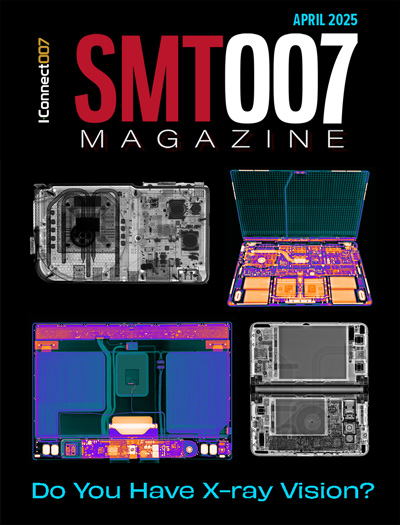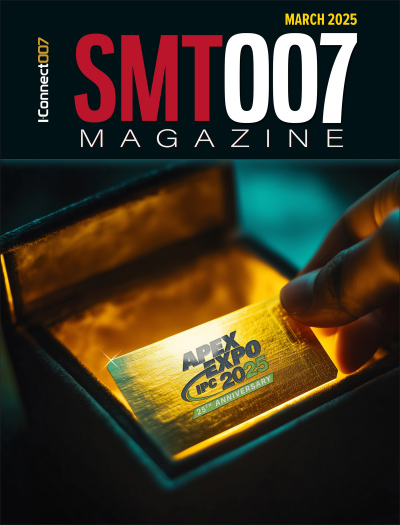-

- News
- Books
Featured Books
- smt007 Magazine
Latest Issues
Current Issue
Do You Have X-ray Vision?
Has X-ray’s time finally come in electronics manufacturing? Join us in this issue of SMT007 Magazine, where we answer this question and others to bring more efficiency to your bottom line.

IPC APEX EXPO 2025: A Preview
It’s that time again. If you’re going to Anaheim for IPC APEX EXPO 2025, we’ll see you there. In the meantime, consider this issue of SMT007 Magazine to be your golden ticket to planning the show.

Technical Resources
Key industry organizations–all with knowledge sharing as a part of their mission–share their technical repositories in this issue of SMT007 Magazine. Where can you find information critical to your work? Odds are, right here.
- Articles
- Columns
Search Console
- Links
- Media kit
||| MENU - smt007 Magazine
Troubleshooting Solder Bridging: Causes and Recommendations
December 31, 1969 |Estimated reading time: 2 minutes
Compiled by Cookson Electronics
Bridging is defined as solder misconnecting two or more adjacent pads that come into contact to form a conductive path. Bridges can be caused by problems at various points in the assembly process. This article examines root causes and solutions at stencil manufacture, screen print, component placement, reflow, PCB manufacture, and solder paste.
PCB Manufacture When PCBs lead to bridging, it is because SMD pads created a coplanarity issue resulting in poor gasketing during printer setup. To eliminate the problem, remove solder mask between adjacent pads, especially for fine-pitch components.
When PCBs lead to bridging, it is because SMD pads created a coplanarity issue resulting in poor gasketing during printer setup. To eliminate the problem, remove solder mask between adjacent pads, especially for fine-pitch components.
Stencils At the design stage, control the aperture size. For fine-pitch components, it is highly recommended to have the opening slightly smaller than landing pad size to improve stencil to PCB gasketing.
At the design stage, control the aperture size. For fine-pitch components, it is highly recommended to have the opening slightly smaller than landing pad size to improve stencil to PCB gasketing.
A dirty stencil with paste underneath will contaminate the bare board on the next print, attributing a potential bridge. To mitigate the possibility of this error, verify zero print gap set up, use the minimum necessary print pressure, increase wipe frequency, and/or change the specified cleaning chemicals.
Stencil tension also affects defect formation. If the tension is loose, consistent printing is impossible, and printed patterns will be ill-defined.
Paste and Screen Print ProblemsScreen printing can be a source of solder bridges due to poor gasketing, misalignment, bad cleaning, dented squeegee blades, and incorrect print speed or support. Gasketing and alignment are corrected by optimizing the print tool. Smearing and bridges caused by poor cleaning can be resolved by ensuring stencils are dry before the next print and optimizing the wet, vacuum, dry sequence.  Poor print definition, with dog ears, is commonly found on fine-pitch apertures. To reduce the risk of bridges from dog ears, check the board support, adjust the separation speed, and make sure solder paste chemistry is taken into account for each set up.
Poor print definition, with dog ears, is commonly found on fine-pitch apertures. To reduce the risk of bridges from dog ears, check the board support, adjust the separation speed, and make sure solder paste chemistry is taken into account for each set up.
 When solder paste causes print defects, it can be the result of dry paste phenomenon, which leads to irregular print shape and inconsistent print volume. Verify that solder paste is not expired, operating temperatures are within supplier's recommendations, and printer temperature is around 25°C at 50% relative humidity (RH). Do not mix using new and old paste. Out-of-spec operating temperatures can also cause good paste to ooze out of pads, which may cause connections with adjacent pads. If temperatures are normal and this persists, verify with another batch of paste to confirm that the problem is batch-related. Perform cold and hot slump tests using IPC-TM-650 Method 2.4.35.
When solder paste causes print defects, it can be the result of dry paste phenomenon, which leads to irregular print shape and inconsistent print volume. Verify that solder paste is not expired, operating temperatures are within supplier's recommendations, and printer temperature is around 25°C at 50% relative humidity (RH). Do not mix using new and old paste. Out-of-spec operating temperatures can also cause good paste to ooze out of pads, which may cause connections with adjacent pads. If temperatures are normal and this persists, verify with another batch of paste to confirm that the problem is batch-related. Perform cold and hot slump tests using IPC-TM-650 Method 2.4.35.
Component Placement Placement inaccuracy will narrow the gap between pads, increasing the chance of bridging. Verify component placement pressure for each product. Use X-ray inspection to verify correct BGA placement; microscopy for QFNs.
Placement inaccuracy will narrow the gap between pads, increasing the chance of bridging. Verify component placement pressure for each product. Use X-ray inspection to verify correct BGA placement; microscopy for QFNs.
 Excessive component placement pressure will squeeze paste out of pads. Verify the actual component height against data entered in the machine if this occurs. Component placement height should be ±1/3 of paste height.
Excessive component placement pressure will squeeze paste out of pads. Verify the actual component height against data entered in the machine if this occurs. Component placement height should be ±1/3 of paste height.
Reflow Profile Extended soak will input more heat to the paste and result in paste hot slump phenomenon. If possible, adopt a straight ramp to spike profile, without a soak zone.
Extended soak will input more heat to the paste and result in paste hot slump phenomenon. If possible, adopt a straight ramp to spike profile, without a soak zone.


